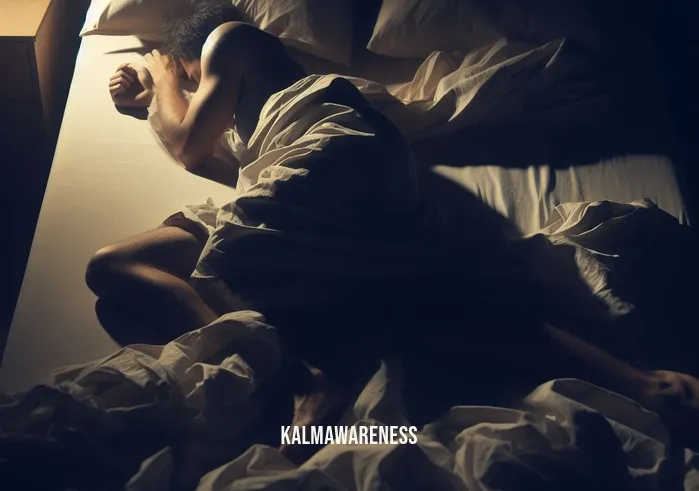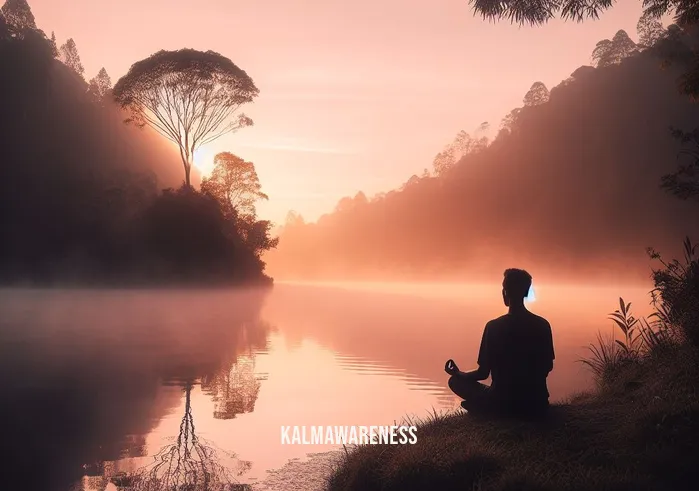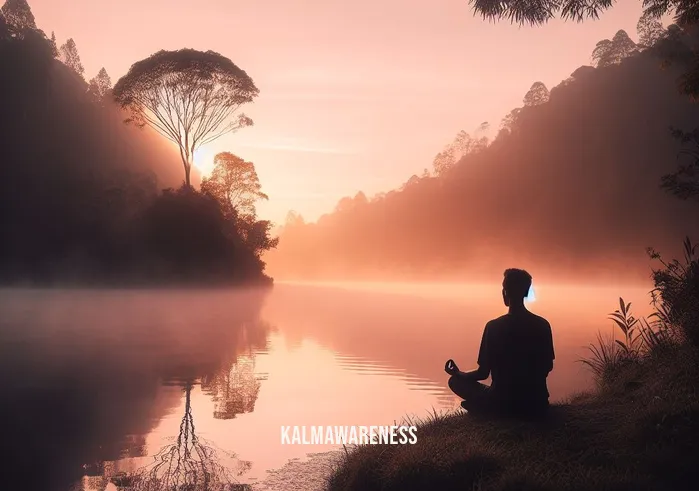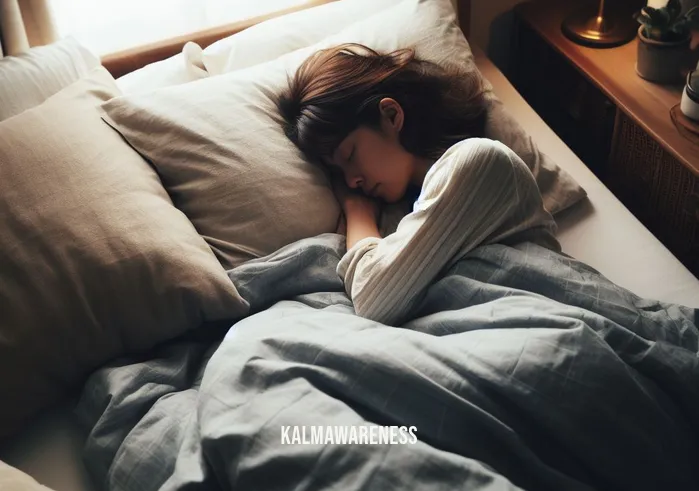Meditation for Sleep and Pain: An In-depth Exploration
The challenges of modern life often leave us searching for tools to alleviate pain and induce restful sleep. One such powerful tool that has been around for millennia, yet remains as effective as ever, is meditation. Meditation for sleep and pain offers a unique solution to both problems, blending the traditions of mindfulness with relaxation exercises. This guide aims to delve deeply into the transformative power of meditation, demonstrating its ability to usher in peaceful slumber and alleviate discomfort.
The Intricate Connection between Sleep, Pain, and Meditation Techniques
Sleep and pain, seemingly distinct experiences, share an intricate connection. Disturbed sleep patterns often exacerbate pain sensitivity, while chronic pain disrupts the sleep cycle. This vicious cycle leaves many individuals caught in a loop of discomfort and exhaustion. However, it is here that meditation techniques come to the rescue. These techniques, which encompass everything from focused attention to mindful movement, present a solution that addresses the root causes rather than merely the symptoms.
Mindful movement for sleep, in particular, encourages the body and mind to release tension and find harmony. This practice, explored in depth at Mindful Movement Sleep, promotes relaxation by connecting the physical to the mental, offering a respite from the discomforts that hinder rest.
The Power of Mindfulness
Mindfulness is the art of being present. It asks us to keep in mind our immediate experiences, allowing us to observe without judgment. By practicing mindfulness, we cultivate an awareness that detaches us from our immediate reactions, thus enabling us to navigate the challenges of pain and sleeplessness with grace.
The link between mindfulness and sleep is undeniable. Those who incorporate gratitude meditation for sleep, for instance, often report more restful nights, as this practice shifts focus from distress to thankfulness.
Embracing Relaxation Exercises
Relaxation is an integral element of some meditation exercises. By teaching our body and mind to stabilize, we can combat the restlessness that pain and sleeplessness often bring. A relaxed state, as explored in Involves Attaining a Peaceful State of Mind, lets us disengage from worrisome thoughts, setting the stage for tranquility and ease.
Furthermore, for those unsure of their ability to meditate in a traditional seated position, the good news is that you can meditate lying down. This approach can be particularly beneficial for those seeking meditation for sleep, as it merges the practice seamlessly into the bedtime routine.
Breathing: The Essential Element
At the heart of many meditation practices lies the art of breathing. It’s an element of some meditation exercises that is often underrated but plays a pivotal role in grounding and calming the mind. By focusing on our breath, we draw our attention inward, away from external distractions. This internal focus allows for a deep connection with the self, facilitating relaxation and pain relief.
A Glimpse Ahead
As we proceed, our journey into the world of meditation for sleep and pain will deepen. We will uncover the insights behind practices like Rouse Yoga and the spiritual benefits of mirror gazing. Additionally, we will explore the ways in which sustainable self-care intertwines with meditation, ensuring that our approach to well-being is holistic.
With such promising avenues to explore, the following chapters promise a treasure trove of knowledge and techniques that will empower readers to find tranquility amidst life’s chaos. Whether you’re a beginner seeking guidance or an experienced practitioner looking for deeper insights, there’s something for everyone.
Stay with us as we delve further into the transformative potential of meditation for sleep and pain. Your path to a more rested and pain-free life is just around the corner. Continue reading to unlock the secrets that await in the next chapter.

The Transformative Power of Meditation Techniques: A Closer Look
While our introductory segment shed light on the foundational aspects of meditation for sleep and pain, it’s time to dive deeper, exploring the nuances and variations of meditation techniques. This chapter promises a comprehensive exploration, unveiling the transformative potential of various practices. With a blend of lists and tables, we’ll present the facets of meditation in an organized and easy-to-understand manner.
Different Meditation Techniques to Combat Sleep and Pain
Mindful Hypnobirthing: A specialized technique that has origins in childbirth practices but has now been adapted more broadly for pain and relaxation. Mindful Hypnobirthing focuses on self-hypnosis, breathing, and visualization exercises to reduce pain and promote relaxation.
Mirror Gazing Meditation: An ancient practice with spiritual benefits, this form of meditation requires one to gaze into their own reflection, which aids in self-awareness, reducing mental chatter, and bringing about a restful state.
Jack Kornfield’s Techniques: Jack Kornfield, a meditation expert for beginners, provides a plethora of techniques suitable for novices. His methods emphasize simplicity, making them perfect for those looking to start their meditation journey.
Train Your Mind Techniques: Techniques that focus on strengthening mental resilience. As highlighted in Train Your Mind to be Stronger than Your Feelings, these practices not only help with sleep and pain but also in cultivating mental fortitude.
Sustainable Self-Care Meditation: Rooted in the principles of longevity and holistic well-being, sustainable self-care integrates meditation with daily practices to ensure a balanced life.
A Comparative Glimpse: Key Meditation Techniques
| Meditation Type | Primary Focus | Benefits |
|---|---|---|
| Mindful Hypnobirthing | Self-hypnosis, Breathing, Visualization | Reduces pain, Enhances relaxation |
| Mirror Gazing Meditation | Self-awareness, Reduction of mental chatter | Boosts self-awareness, Promotes calm |
| Jack Kornfield’s Techniques | Simplicity and accessibility | Ideal for beginners, Comprehensive |
| Train Your Mind Techniques | Mental resilience | Enhances mental strength, Assists in managing pain |
| Sustainable Self-Care Meditation | Integration of meditation in daily routine | Ensures holistic well-being, Promotes longevity |
How Meditation Addresses Pain Perception
The human mind plays a crucial role in the perception of pain. Techniques such as those offered in Judgement of the Wise allow individuals to shift their perspective on pain. Instead of viewing it as a constant antagonist, meditation teaches us to see pain as a fleeting sensation, a temporary experience rather than a permanent state.
Techniques for Sleep Enhancement
A restful night’s sleep is often elusive, but meditation brings it within reach. Techniques such as How We Get Deep So Fast provide insights into rapidly inducing deep, restorative sleep through meditation. Such practices not only improve the quality of sleep but also its duration, ensuring individuals wake up refreshed and rejuvenated.
Closing Thoughts
The universe of meditation for sleep and pain is vast and brimming with potential. Every technique, every practice holds the promise of transformation. As we’ve explored in this chapter, meditation not only addresses the symptoms of sleeplessness and pain but also targets their root causes, offering lasting solutions.
But the journey doesn’t end here. In the next chapter, we will venture into the world of specialized meditation practices, dissecting their origins, practices, and benefits. From the serenity of Rouse Yoga to the deep insights of Mindful Movement, get ready to unravel meditation’s myriad treasures. Continue reading to embark on this enlightening journey.

Illuminating Paths: Hope and Inspiration Through Meditation for Sleep and Pain
Navigating the realms of pain and disrupted sleep can be a daunting task, often leaving many in despair. Yet, within the age-old practice of meditation lies a beacon of hope—a path illuminated with stories of triumph and rejuvenation. This chapter seeks to inspire by showcasing real-life tales of transformation and reinforcing the significance of meditation for sleep and pain.
Resounding Voices: Quotes on Healing and Restoration
As we meander through the journey of life, words of wisdom from others often serve as guiding lights. Let’s soak in some profound reflections relevant to our quest:
- “The wound is the place where the light enters you.” – Rumi
- “In the midst of winter, I found there was, within me, an invincible summer.” – Albert Camus
- “Every breath we take, every step we make, can be filled with peace, joy, and serenity.” – Thich Nhat Hanh
- “Sleep is the best meditation.” – Dalai Lama
- “Out of difficulties grow miracles.” – Jean de La Bruyère
Stories of Triumph: Real-Life Inspirations
Anna’s Journey with Mindful Movement Sleep: Anna, a software engineer, grappled with chronic insomnia. An accidental discovery of the Mindful Movement Sleep technique not only aided her sleep but also reduced her persistent neck pain. Within weeks, she transformed from a weary individual to someone brimming with life.
Michael’s Encounter with Teenagers Walking: Michael, a high school teacher, witnessed first-hand the power of walking meditation. Integrating it into his classroom routine, he saw remarkable changes in his students—reduced anxiety, improved concentration, and better sleep patterns.
Sophia’s Dive into Meditation Made Simple: Battling fibromyalgia, Sophia felt trapped in a cycle of pain and sleepless nights. Her life took a turn when she embraced Meditation Made Simple techniques. The practices not only alleviated her pain but also brought tranquility to her nights.
The Ripple Effect of Meditation
Beyond personal stories, it’s worth noting how meditation for sleep and pain creates a ripple effect, touching not just the individual but also their surroundings. A well-rested person, free from the shackles of pain, exudes positivity, enhancing their interactions with others. They become more productive at work, more present in relationships, and spread a contagion of hope.
Meditation: Not Just a Practice but a Lifeline
It’s evident that meditation isn’t merely a set of practices—it’s a lifeline for many. By touching that body part that aches or by simply focusing on one’s breath, individuals find solace, pain relief, and restful slumber. The beauty of meditation lies in its simplicity and accessibility, making it a ray of hope for countless souls worldwide.
The Road Ahead
While we’ve delved into the heartening tales of those who found respite through meditation, our exploration is far from over. In the next chapter, we’ll uncover the scientific backbone supporting these stories, diving deep into the mechanics and research behind meditation’s efficacy for sleep and pain. This blend of heartfelt stories and empirical evidence promises a comprehensive understanding of our theme. Stay with us, as the ensuing revelations promise to be both enlightening and empowering. Continue reading to unravel the science behind the magic.

Unraveling the Mysteries: Meditation for Sleep and Pain Demystified
Throughout our journey, we’ve traversed the vast landscape of meditation for sleep and pain. From heartfelt stories to words of wisdom, we’ve gathered myriad perspectives. Now, it’s time to delve deeper, breaking down the intricate dynamics of meditation. Through lists and bullet points, we aim to simplify, elucidate, and empower.
Fundamental Principles Behind Meditation for Sleep and Pain
Focused Attention: One of the cornerstones of meditation. By directing one’s attention, either towards a mantra, the breath, or a specific body part, the mind is trained to dispel distractions, fostering relaxation.
Mind-Body Harmony: Meditation strengthens the bond between the mind and body, aiding in the alleviation of physical pain and sleep disruptions.
Breath Control: A primary element in many techniques, controlling one’s breathing induces calm and can significantly impact pain perception.
Awareness and Acceptance: Emphasized in Mindful Hypnobirthing, awareness of one’s feelings without judgment can alter the subjective experience of pain.
Benefits of Meditation for Sleep
Deep Relaxation: Techniques such as those in How We Get Deep So Fast facilitate rapid entry into a relaxed state, priming the body for sleep.
Reduced Sleep Latency: The time taken to fall asleep is noticeably reduced.
Improved Sleep Quality: Deeper, more restorative phases of sleep are achieved.
Decreased Reliance on Medication: Many find reduced dependency on sleep-inducing drugs.
Benefits of Meditation for Pain Management
Enhanced Pain Tolerance: Over time, regular meditators report higher thresholds for pain.
Reduced Pain Perception: Meditation can alter how the brain perceives pain, making it less intense.
Decreased Inflammation: Stress-induced inflammation, a contributor to pain, can be controlled through meditation.
Increased Positivity: A positive mindset, cultivated through practices such as gratitude meditation, can impact pain experiences.
Key Meditation Techniques and Their Core Focus
Mindful Movement Sleep: Targets the release of physical tension.
Mirror Gazing: Aids in mental relaxation and self-awareness.
Jack Kornfield’s Methods: Simplifies meditation, making it accessible to all.
Train Your Mind Techniques: Fortifies mental resilience, beneficial for managing chronic pain.
Common Misconceptions
Meditation is Religious: While it has spiritual roots, modern meditation practices, like those discussed in Meditation Made Simple, are secular.
Meditation Requires Hours: Just a few minutes daily can make a difference.
Only Certain People Can Meditate: Meditation is universal, irrespective of age, as highlighted by practices like Teenagers Walking.
Final Thoughts
As we’ve broken down the complexities, it’s evident that meditation for sleep and pain is not just a practice but a holistic approach to well-being. It’s an art, a science, and, for many, a lifeline.
Our journey is nearing its conclusion, but there’s still much to uncover. In our final chapter, we’ll synthesize our learnings, providing a roadmap for those keen to embark on this transformative journey. Stay with us as we weave the threads together, illuminating a path of hope, healing, and harmony. Continue reading to embrace the culmination of our exploration.

Navigating the Voyage: Reflections on Meditation for Sleep and Pain
As we reach the culmination of our enlightening exploration, it’s time to pause, reflect, and truly grasp the essence of what we’ve discovered. Our journey through the world of meditation for sleep and pain has been one of revelations, insights, and profound transformations. Let’s retrace our steps, celebrate our learnings, and envision the brighter horizons ahead.
Recapping Our Odyssey
From the ancient roots of meditation to its modern-day manifestations, we have delved deep into its myriad facets:
The Link: We commenced by understanding the intricate connection between sleep, pain, and meditation, where practices like Mindful Hypnobirthing offer a bridge to tranquility.
Inspiration and Hope: Heartening tales of individuals who turned their lives around demonstrated meditation’s transformative power.
Demystification: We broke down complex topics into bite-sized insights, aiding comprehension and fueling aspirations.
Applications and Benefits: We’ve come to recognize meditation not just as a set of practices but as a holistic approach to well-being, with a slew of benefits ranging from mental fortitude, as highlighted in Train Your Mind Techniques, to holistic self-care.
Infusing Knowledge into Reality
While knowledge is power, its true strength lies in application. Consider the following steps:
Start Small: You don’t need hours. Even a few minutes daily can make a difference.
Stay Consistent: Like any skill, meditation flourishes with regular practice.
Seek Guidance: Delve deeper into our collection, exploring topics like Rouse Yoga or Mindful Movement Sleep for added insights.
A Heartfelt Note to Our Readers
Dear readers,
Thank you for embarking on this enlightening journey with us. Your engagement and curiosity have been the driving force behind our exploration. As we wrap up this chapter, remember that every ending is a new beginning. We hope this guide has provided you with a foundation, but the world of meditation is vast and ever-evolving.
A Call to Exploration: Dive deeper into our magazine’s treasure trove. Revisit previous sections for a refresher or explore fresh topics that resonate with your quest. Our element of some meditation exercises is a great place to start!
Forward Bound
While our voyage on meditation for sleep and pain concludes here, remember, there’s always more to discover, more to learn. Stay with us for more insights, explorations, and revelations in our forthcoming editions. Let’s continue this journey together, forging paths of well-being, peace, and holistic health. Until next time, dear reader, may you find tranquility in every breath and solace in every moment.




